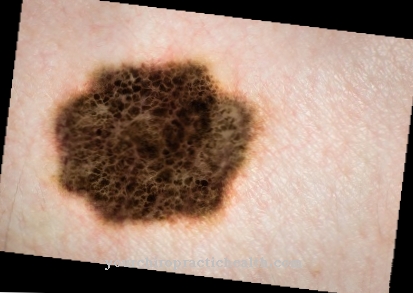A patient suffers Splenomegaly, its spleen is abnormally enlarged. Therapeutic steps usually deal with the underlying disease.
What is splenomegaly?

© gritsalak - stock.adobe.com
The concept of Splenomegaly describes in medicine an enlargement of the spleen. Depending on the person affected, a Enlargement of the spleen concern the weight or dimensions of the organ. In healthy people, the spleen measures an average of 4 centimeters wide and 11 centimeters long and weighs 350 grams on average.
As a rule, splenomegaly is not considered an independent disease - rather, the enlargement of the spleen occurs as a symptom of various possible clinical pictures.
Symptoms of splenomegaly depend, among other things, on the extent of enlargement of the spleen and the underlying disease; For example, splenomegaly can exert pressure on neighboring organs and in this way cause pain. Depending on the underlying disease, splenomegaly is also often accompanied by fever or joint problems.
causes
Possible causes one Splenomegaly are diverse. For example, acute or chronic infections such as malaria can result in splenomegaly. Various forms of leukemia (blood cancer) also lead to the development of splenomegaly.
In addition, sarcomas (malignant tumors) or cysts (fluid-filled tissue cavities) of the spleen can cause splenomegaly. Other underlying diseases that can promote splenomegaly include rheumatological or lymphatic (affecting the lymphatic system) diseases.
Anemia in the form of spherical cell anemia can also be associated with splenomegaly - spherical cell anemia is primarily characterized by an abnormally increased breakdown of red blood cells by the spleen. Finally, within the scope of possible causes of splenomegaly that affect the spleen in an isolated way, bruises (hematomas) or blood sponges (hemangiomas) of the organ should be mentioned.
Symptoms, ailments & signs
The enlargement of the spleen is accompanied by symptoms of the underlying disease in addition to the symptoms caused by the swelling itself. The large spleen causes a feeling of pressure under the left costal arch. Pain is also possible. If the organ is so swollen that the capsule surrounding it ruptures, extreme pain occurs in the left upper abdomen, which can radiate into the shoulder.
In addition, there are symptoms of the underlying illnesses that cause it. If there is an underlying infection, fever and general fatigue may occur. Often the lymph nodes are swollen, the patients feel sick and weak. Cancer can also cause the spleen to swell and, depending on the place of origin, trigger various complaints.
If the digestive tract is affected, diarrhea can occur. If the liver is involved, jaundice can occur, as well as fever, loss of appetite, and weight loss. But excessive appetite is also possible. If the trigger is a blood disorders, anemia and night sweats can occur.
Patients have pale skin and feel powerless. Obstruction of the portal vein drainage can also lead to an enlarged spleen. If the cause is heart failure, it manifests itself in shortness of breath, decreased performance, pulmonary edema or asthma. Due to the insufficient supply of oxygen, the skin and mucous membranes turn bluish, edema forms on the legs and fluid collects in the abdomen.
Diagnosis & course
Noting a Splenomegaly The first step is usually a physical examination by the diagnosing doctor - in contrast to a healthy spleen, an enlarged spleen can be palpated as part of splenomegaly.
If a corresponding physical examination indicates an enlarged spleen, the exact extent of the splenomegaly can be determined with the help of an ultrasound examination, for example. Since splenomegaly is often associated with an overactive spleen or an excessive breakdown of blood cells, a patient's blood count is usually checked with a blood sample.
Depending on the underlying disease that is hidden behind splenomegaly, enlargement of the spleen can take an acute (temporary) or chronic (long-term) course. In the individual case, the course of splenomegaly depends primarily on successful treatment of the underlying disease.
Complications
Splenomegaly can lead to gastrointestinal discomfort, tiredness and general weakness. Serious complications arise when the disease is treated too late or inadequately. Then there can be secondary symptoms such as chronic pain, infections and visual changes. Outwardly, the advanced stage of splenomegaly shows itself as paleness, blue fingers and noticeable skin changes - aesthetic flaws that can further worsen the patient's mental state.
Finally, secondary illnesses occur that are associated with further complaints. A typical complication of splenomegaly is hypersplenism, i.e. an overactive spleen. This can lead to a lack of cells and increase the tendency to bleed. When anemia occurs, the patient needs regular blood transfusions. Removal of the spleen has serious implications for the patient's health.
Although regular vaccinations reduce the risk of infections, the body is more susceptible to illness. Some patients experience serious infections months or years after their spleen has been removed, which can be life-threatening. Furthermore, thrombosis can occur in the weeks after the procedure. The prescribed medication can also cause side effects and interactions.
When should you go to the doctor?
With splenomegaly, the person concerned depends on a medical examination and treatment by a doctor. Since this disease cannot heal itself, an early diagnosis is also very important in order to prevent further complications. A doctor should therefore be consulted at the first signs of splenomegaly. A visit to the doctor is necessary if the person is suffering from severe pain in the left side of the upper abdomen.
In most cases, the pain occurs directly on the spleen. If this pain occurs permanently and, above all, occurs without a particular reason, a doctor must be consulted. Symptoms such as diarrhea or fever can also indicate splenomegaly. Some people also have a loss of appetite.
If these symptoms occur, either an internist or a general practitioner can be seen. Further examination and treatment depends heavily on the exact symptoms of splenomegaly and is carried out by a specialist. No general predictions can be made about the further course or life expectancy of the patient.
Treatment & Therapy
Successful treatment of the Splenomegaly usually encounters primarily the individual causal underlying disease. If the disease that caused an enlarged spleen can be successfully cured or controlled, this usually has a positive effect on the existing splenomegaly.
However, the causes of an enlarged spleen cannot always be controlled medically and in some cases an enlarged spleen leads to further complications (such as progressive anemia). Therefore, in rare cases, surgical removal of the spleen (also known as a splenectomy) may be medically necessary. Since the spleen takes on tasks of the immune defense within the human body, a splenectomy is usually associated with an increased risk of infection.
This risk mainly relates to infections caused by certain strains of bacteria. Patients with splenomegaly who are about to have their spleen removed receive a vaccination a few weeks before the planned procedure, which protects the organism from various pathogens. This protection against infection usually has to be renewed at regular intervals after a successful splenectomy.
prevention
Since the Splenomegaly is often the result of a fundamental disease, the enlargement of the spleen itself can only be prevented to a limited extent. As a rule, however, early diagnosis and treatment steps with regard to the causative disease can contribute to the regression of splenomegaly. If a complete regression of splenomegaly cannot be achieved with the help of conservative therapy methods, further progression of the enlargement of the spleen can usually be prevented.
Aftercare
With splenomegaly, the options for follow-up care are usually significantly limited. In some rare cases they are not even available to those affected, so that the patient should first and foremost make a quick diagnosis so that the disease can be treated quickly and early.
Splenomegaly cannot heal itself as a rule, so that without treatment by a doctor, in the worst case, the person affected can die. In most cases, the symptoms can be relieved by taking various medications. The correct dosage and regular intake must always be observed so that the correct treatment is achieved.
If you have any questions or questions, you should first consult a doctor. Furthermore, the person affected should protect himself particularly well against various infections and diseases and should not stay in high-risk areas. Vaccinations can also be very helpful and protect against such infections. Splenomegaly may limit the life expectancy of the person affected. However, the further course cannot be generally predicted.
You can do that yourself
In everyday life, the person concerned can take care to positively stimulate his blood circulation. The consumption of foods that support the production of blood can be used in a targeted manner. Ingesting nuts, pomegranates, or legumes helps in supporting blood formation. At the same time, the consumption of harmful substances such as alcohol and nicotine should be avoided. These lead to a deterioration in health and can cause an increase in symptoms.
If you have a fever, the daily consumption of fluids should be increased. The organism needs more nutrients over time and should be supported by an optimal drink supply. Although the symptoms of the disease include loss of appetite, a sufficient amount of calories should be consumed daily. In order to gather new strength and to support the body's own immune system, it is necessary that a healthy and balanced diet is followed.
Often the cause of splenomegaly can be traced back to cancer. Emotional strength is needed to cope with this disease. The physical symptoms are unusually high and the confrontation with a reduced life expectancy can lead to psychological stress. Relaxation procedures are therefore to be used so that the person concerned can cope better with the disease. The use of yoga or meditation was found to be very helpful by many of those affected.


.jpg)
























